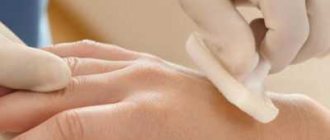Schamberg's disease, or chronic purpura pigmentosa, belongs to a large group of diseases called cutaneous vasculitis (angiitis). The pathology is characterized by nonspecific inflammation of blood vessels located in the dermis and subcutaneous fatty tissue. There are no exact data on the incidence rate of this type of skin vasculitis.
To date, the cause of chronic pigmentary purpura is unknown. The influence of infection (viral, bacterial), systemic pathologies, and the use of certain medications (for example, antibiotics, sulfonamides) on the development of the disease is assumed. In addition, predisposing factors are identified, among which special importance is given to:
- Hypothermia.
- Excessive insolation (sun exposure).
- Heavy physical and mental stress.
- Injuries.
- Surgical intervention.
- Standing for long periods of time.
- Lack of vitamins, minerals and essential nutrients.
- Diabetes mellitus.
- Serious liver diseases.
According to medical statistics, Schamberg's disease in women mainly manifests itself in the form of livedoangiitis (this is one of the clinical forms). However, the disease can occur at any age among both male and female populations.
Schamberg's disease is treated by a dermatologist.
Clinical picture
Chronic pigmentary purpura refers to dermal capillaritis, in which the smallest blood vessels, the papillary capillaries, become inflamed. There is no disturbance in general health. Skin lesions are usually symmetrical and varied. There are no problems with the functioning of internal organs.
Main clinical forms of the disease:
- The petechial type of pigmented purpura is characterized by the appearance of multiple petechiae, which are small punctate hemorrhagic spots. On examination, no swelling is detected. At the end of the acute period, spots with a brownish-yellow tint of various sizes remain. The lower extremities are most often affected. There are no unpleasant subjective sensations.
- With the telangiectatic type, peculiar medallion spots appear. In the central zone there are small telangiectasias (spider veins) against the background of atrophic skin. Small petechiae are found along the periphery against the background of pigmentation (hemosiderosis).
- For the lichenoid type, the appearance of disseminated (widespread) small shiny bodily nodules is typical. In parallel, a petechial rash, age spots and small spider veins are also present.
- With the eczematoid type, in addition to the characteristic pigmentation (hemosiderosis) and petechiae, swelling, diffuse redness, small nodules, blisters and crusts are detected. In addition, patients complain of a feeling of quite intense itching, which, moreover, can periodically intensify and cause significant discomfort.
- Livedoangiitis develops almost only in female patients, usually during adolescence. First, the appearance of bluish spots (livedo) is noted on the legs, arms, torso and face, which form a kind of looped network. Over time, hemorrhages and ulcers appear in the livedo area, which cause severe pain.
In search engines you can find many requests on the topic: “Name synonyms for chronic pigmentary purpura.” Experts also call this disease Schamberg-Majocca disease, hemosiderosis of the skin, hemorrhagic pigmentary dermatosis and chronic dermal capillaritis.
Without an optimal course of treatment, the disease can progress and worsen the patient's condition.
Prevention and prognosis
The reasons for the development of pathology remain a blank spot for clinicians, so there are no specific preventive measures.
You can reduce the risk of developing chronic pigmentary purpura by following these recommendations:
- maintaining a healthy and moderately active lifestyle;
- proper and balanced nutrition;
- avoiding hypothermia;
- constant strengthening of the immune system;
- complete treatment of diseases that can lead to pathology;
- Regularly undergoing a full preventive examination at the clinic.
The prognosis of Schamberg's disease is favorable - complex therapy and complete exclusion of the etiological factor lead to long-term remission. Complications develop extremely rarely.
If you think you have Schamberg's disease
and the symptoms characteristic of this disease, a dermatologist can help you.
Source
Did you like the article? Share with friends on social networks:
Diagnostics
In typical situations, diagnosing Schamberg's disease, the so-called chronic pigmentary purpura, is not particularly difficult for a qualified specialist. A preliminary diagnosis is usually made during a clinical examination of the patient. The degree of disease activity is determined based on the nature and extent of lesions on the skin, as well as changes in blood test values.
The diagnosis can be confirmed by histological examination of the affected area of the skin. A biopsy may be resorted to in case of persistent or atypical course of the disease. The appropriateness of additional methods of examining the patient is determined by the attending physician.
Features of managing patients with any type of skin vasculitis:
- It is necessary to determine the clinical form of the disease.
- Assess the degree of activity.
- Taking into account the clinical form of the disease and the severity of manifestations, select the type and type of treatment.
- Carrying out effective preventive measures.
If progression of the disease or second degree of activity is observed, the patient should be hospitalized and treated in an inpatient setting. During exacerbations of vasculitis, especially when the pathological process is concentrated in the legs, it is recommended to adhere to bed rest. Therapeutic exercises that improve peripheral circulation are also useful.
If possible, eliminate the possible cause of the disease (for example, infections, systemic disease, etc.). Drugs from the quinolone group are prescribed as drug therapy. Hydroxychloroquine is used orally for 60–90 days. During treatment, it is necessary to monitor the main blood tests once every 30 days. Angioprotectors and drugs that normalize microcirculation (Pentoxifyline, Dipyridamole) are used. Venotonic and venoprotective drugs (Hesperidin, Diosmin) are used. The general course of treatment should last at least 1–2 months. It is recommended to additionally take vitamin and mineral complexes containing ascorbic acid, retinol, tocopherol, etc.
Local therapy for this skin vasculitis includes the use of the following external medications:
- Glucocorticosteroid drugs (Mometasone, Betamethasone, Methylprednisolone). Lubricate the affected areas 1-2 times a day until clinical improvement. The duration of treatment should not exceed 12 weeks.
- Angioprotectors and drugs that normalize microcirculation. Use Troxerutin twice a day.
- Anticoagulants. Use 2-3 times a day until clinical improvement. The average duration of therapy is about 2 weeks.
It is strictly not recommended to self-medicate and use folk remedies without consulting a specialist. Such amateur activities often lead to the development of various kinds of complications and serious consequences.
The course of treatment is prescribed taking into account the severity of the clinical manifestations and symptoms of Schamberg’s disease.
In the vast majority of cases, patients with Schamberg vasculitis can expect a favorable prognosis. Acute variants are usually characterized by cyclicality with periodic ups and downs. Spontaneous regression (disappearance or significant reduction in clinical symptoms of the disease) is often observed. Chronic Schamberg's purpura pigmentosa can usually be controlled with an adequate course of treatment and prevention.
Prevention
As dermatological practice shows, after eliminating the symptoms of skin vasculitis, it is strongly not recommended to stop the therapeutic course. Less intensive therapy continues until laboratory values return to normal. In addition, the patient is left on a maintenance course for 6–10 months. Angioprotectors and drugs that normalize microcirculation are mainly used.
Read also: Center for Endovascular Surgery
As far as possible, we exclude provoking factors (hypothermia, heavy loads, long walks, trauma, etc.). If necessary, the patient is given temporary disability. It is recommended to reconsider your lifestyle. A balanced diet and balanced physical activity significantly increase the chances of achieving stable remission. To prevent exacerbations, you should undergo a comprehensive examination every three months.
Reasons for the development of the disease
To date, the exact causes of Schamberg's disease have not been identified. However, most doctors are inclined to believe that damage to the capillary walls is of an autoimmune nature. That is, the body’s immune system, due to some kind of malfunction, begins to perceive the cells of its own blood vessels as foreign. As a result of an immune attack, the walls of blood vessels are damaged, and some of the blood circulating through them gets under the skin.
Outwardly, this manifests itself as pinpoint hemorrhages. Over time, the iron contained in red blood cells is converted into a special pigment (hemosiderin), which gives the skin a specific brown color.
Causes of Schamberg's disease
The pathogenesis and sources of the disease have not yet been established, however, many specialists in the field of dermatology believe that the main provocateur of the disease is the occurrence of an autoimmune process in the human body. Against this background, what happens:
- increased permeability of capillary walls;
- intradermal petechial hemorrhage;
- release of hemoglobin from the vascular bed;
- conversion of iron into the pigment hemosiderin;
- the formation of spots on the skin with a specific shade.
Possible provocateurs include:
- diabetes;
- prolonged hypothermia of the body;
- chronic course of any infectious disease;
- fungal diseases;
- wearing low-quality winter clothing that does not cover the lower leg or foot - this leads to cold spasm of small blood vessels.
Clinical picture
The main symptoms of Schamberg's disease:
- Skin rashes with a symmetrical arrangement. First, groups of pinpoint hemorrhages are formed on the skin, combined with dilation of the superficial vessels of the skin. Over time, the groups merge to form plaques of varying shades of brown.
- New red rashes appear along the edges of the formed plaque. And later, the middle part of the plaque gradually becomes thinner and slowly atrophies.
- Along the edges of the plaques, an increase in the skin pattern can be observed, and sometimes itching is noted.
- With Schamberg's disease, the rash is localized mainly on the legs and thighs. The skin of the arms and torso is affected much less frequently.
- Schamberg's disease is characterized by a positive Koebner sign. In patients, new rashes appear at the site of superficial skin damage.
- Some patients with Schamberg's disease experience changes in blood composition - a decrease in the number of red blood cells, thrombocytopenia, etc.
- Changes in internal organs are not typical for Schamberg's disease.
Symptoms of the disease
Among the main symptoms of this disease, experts identify:
- A characteristic rash that is located symmetrically. Initially, groups of hemorrhages appear on the skin and the superficial vessels of the skin dilate. Over time, these groups join together and brownish plaques form.
- The appearance of a new rash, but already red in color. It forms along the edges of the formed plaque. The plaque itself begins to thin out in the middle and gradually atrophy.
- Increased skin pattern along the edge of the plaque.
- Itching appears.
With this disease, characteristic rashes spread to the thighs and legs. The upper limbs and other areas of the body are extremely rarely affected.
Schamberg's disease in some cases can change the composition of the patient's blood, for example, reducing the number of red blood cells. The disease does not cause changes in internal organs.
When the disease occurs, the walls of blood vessels are affected, and some of the blood gets under the skin. Externally, the disease manifests itself as small pinpoint hemorrhages, and the iron contained in red blood cells is converted into hemosidirin, which gives the skin a characteristic brown tint.
Initially, the disease may manifest itself in the form of group rashes that are located symmetrically. Pinpoint hemorrhages coalesce over time and form brown plaques.
Then new rashes form along the edges, an intensification of the pattern on the skin may be observed, and the patient often experiences severe itching in the affected areas.
The localization of rashes is the lower extremities, thighs; on the arms and other parts of the body such rashes are observed quite rarely.
A positive Koebner's sign is another sign of Schamberg's disease. With superficial skin lesions, new rashes may occur. In some patients, the composition of the blood changes, the number of red blood cells, platelets and other components decreases or increases.
The disease has several forms; depending on the nature, the symptoms and nature of the disease will depend.
Rashes with this phenomenon are characterized by symmetry. Externally, dark spots on the skin can be quite varied.
After old petichiae (minor hemorrhages) are eliminated, new ones appear. General health remains normal, the patient can lead a full life.
Only the skin capillaries are damaged, so the disease is characterized by a benign course. There is no danger of hemorrhage into internal organs.
However, you cannot delay contacting a dermatologist. Another dangerous pathology may be hidden under the symptoms of Schamberg's disease.
There are four types of hemosiderosis:
- petechial;
- telangiectatic;
- lichenoid;
- eczematous.
The petechial type of the disease is characterized by the appearance predominantly of dark spots with different outlines on the skin of the lower leg. There is no swelling or any discomfort.
In most cases, symptoms of the disease appear on the legs
With the telangiectatic type, round lesions appear on the skin, in the center of which spider veins form. Hemorrhages can be localized to any part of the body.
The lichenoid type of the disease is characterized by the appearance of brown nodules that rise slightly above the surface of the skin. Petechial type symptoms are also present.
In Schamberg's disease, the rashes are characterized by a variety of appearance and symmetry. The diversity lies in the presence of both old and new petechiae on the skin. Schamberg's disease will not cause changes in a person's well-being; he may not even suspect anything. Schamberg's disease is characterized by damage to only the skin capillary. The disease is benign. No hemorrhages into internal organs are observed.
Forms of the disease
Schamberg's disease can occur in different forms, each of which has characteristic symptoms.
- The petechial form of Schamberg's disease is characterized by the appearance of a large number of uneven spots, consisting of a large number of pinpoint hemorrhages. Gradually, the spots acquire first a yellow and then a brown tint. The patient does not experience physical discomfort. The petenchial form of Schamberg's disease is more common in men, and the spots are localized exclusively on the legs.
- The telangiectatic form of Schamberg's disease is manifested by the appearance of medallion-shaped spots. In the center of the spots you can see spider veins formed by dilated capillaries. Along the edges of the “medallions” you can see pinpoint hemorrhages in the form of red spots.
- The lichenoid form of Schamberg's disease is distinguished by a combination of petenchial rashes with the formation of small nodules. With this form of Schamberg's disease, the skin tone changes slightly, and rashes can appear in any part of the body.
- The eczematoid form of Schamberg's disease is the most painful for the patient. With this type of disease, along with pinpoint hemorrhages (petechiae), eczema forms on the skin. The rash often causes itching and discomfort to the patient.
Classification
Chronic pigmentary purpura exists in the following forms:
- Petechial. In most situations, it is diagnosed in males. In such cases, the rash is localized only on the lower extremities. Externally they resemble spots that can have different sizes and shapes.
- Lichenoid. Pinpoint hemorrhages are evenly distributed throughout the body.
- Telangiectatic. The rash forms regularly shaped spots like a medallion. In the center of such a skin neoplasm, a pattern of damaged blood vessels is observed.
- Eczematous. Patients experience eczema-type rashes. This means that small bubbles form, and when they spontaneously burst, a crust appears.
Diagnostic methods used
Since most forms of Schamberg's disease do not cause pain or other unpleasant sensations, patients often doubt whether they need to see a doctor.
The answer to this question is clear: definitely! The fact is that differential diagnosis may be required, since Schamberg's disease has similar symptoms to other diseases. For example:
- Gougerot-Blum pigmentary dermatitis;
- Senile purpura of Bateman;
- Majocchi ring-shaped purpura;
- Varicose dermatitis;
- Kaposi's sarcoma, etc.
Only a doctor can make a correct diagnosis after conducting the necessary research.
For an accurate diagnosis it is necessary:
- Conducting a visual inspection;
- Conducting a blood test to determine iron levels and the ability of the blood to “bind” iron.
- A desferal test may be required. To do this, the patient is injected intramuscularly with 500 mg of desferal. After this, urine is collected (during the first 6-24 hours after administration) and analyzed for iron content.
- To make a diagnosis, dermatoscopy is often prescribed - examination of the skin under high magnification. When conducting this study in patients with Schamberg's disease, one can notice swelling of the capillary walls, dilation along the surface vessels, and accumulation of immune cells in the papillary layer of the dermis.
Treatment using official medical methods
To treat Schamberg's disease, the doctor selects the necessary medications and gives the patient recommendations for changing their usual lifestyle.
For Schamberg's disease, oral medications may be prescribed:
- To stop the inflammatory process - non-steroidal anti-inflammatory drugs.
- To relieve itching, use products containing corticosteroids.
- To increase the strength of the walls of blood vessels - calcium and potassium preparations, as well as vitamins of groups C, P and K.
For Schamberg's disease, it is recommended to use topical agents:
- To relieve inflammation and itching - ointments containing corticosteroids.
- To strengthen capillaries - ointments containing heparin
Diet and lifestyle recommendations
Patients diagnosed with Schamberg's disease are advised to follow a diet that excludes the consumption of irritating and allergic foods. It is necessary to refuse:
- Chocolate;
- Smoked meats;
- Fried foods;
- Citrus;
- Strongly brewed tea and coffee;
- Alcoholic drinks.
- Spicy seasonings.
You should try to avoid:
- Long tiring walking;
- Staying on your feet for a long time;
- Hypothermia and overheating;
- Bruises and superficial injuries.
Treatment
Patients diagnosed with Schamberg's disease must follow a diet. It is recommended to exclude from the diet foods that can cause allergic reactions. These include citrus fruits, spicy foods, chocolate, tea, coffee, smoked foods, etc. It is advisable to avoid hypothermia, bruises and excessive physical exertion. Particular attention should be paid to the treatment of concomitant diseases, as well as endocrine disorders.
Treatment of Schamberg's disease, given its autoimmune nature, involves the use of corticosteroids (Prednisolone, Dexamethasone and others). Anti-inflammatory drugs (Ibuprofen and others), angioprotectors and antiplatelet agents are also used. If Schamberg's disease is severe, patients are prescribed procedures such as cryoprecipitation, hemosorption, and plasmaphoresis.
Treatment using traditional medicine methods
Along with following the doctor’s recommendations, you can use traditional medicine aimed at strengthening the walls of blood vessels.
Read also: Consequences of vasculitis
Mountain arnica is used to treat Schamberg's disease.
An infusion prepared from mountain arnica and hazel bark has a good effect on Schamberg's disease. Plant materials are taken in equal proportions, then a spoonful of the mixture is brewed with half a liter of boiling water. The infusion should be prepared in a thermos and left for at least 12 hours. You need to take it before meals three times a day, a single dose is half a glass.
For Schamberg's disease, a concentrated decoction of thick-leaved bergenia can help. Three tablespoons of dry crushed raw materials are poured into 250 ml of boiling water. Boil until half the liquid has evaporated. Then the broth is filtered. Take the concentrated decoction three times a day, 20 drops.
Schamberg's disease: symptoms
The symptoms of the disease are obvious and do not differ externally in all types of patients, but the external manifestation may differ due to the presence of hemorrhages of varying duration. During the illness itself, there is no deterioration in the general condition of the human body, since, apart from the skin, hemorrhages do not occur anywhere.
Schamberg's disease is divided into four main types:
- Pathechial - occurs mainly in men, manifests itself in the form of a rash on the thighs and legs. The spots have different sizes and irregular shapes. The spots consist of several hemorrhages at once, which, as they develop, can acquire different shades. The disease itself does not cause pain, swelling or discomfort.
- Telangiectatic - rashes are not localized in specific places and occur throughout the body. In the center of the spots there are deformed and enlarged vessels. The rashes themselves also do not cause any discomfort; itching and pain do not appear.
- Lichenoid - rashes appear abundantly throughout the body, and some spots have a shiny surface that does not change.
- Eczematous - this type has a number of manifestations similar to eczema in the form of swelling of the affected areas, itching and the appearance of crusts of dried blood.
Spots on the leg due to Schamberg's disease
Description of Schamberg's disease
The mechanism of development of the disease is not fully understood. Many experts believe that changes in capillary walls occur due to autoimmune disorders in the patient’s body. As a result, the permeability of blood vessels increases and their walls weaken. The consequence of this is minor hemorrhages.
The disease is characterized by the formation of brown spots on the skin due to damage to the capillaries
A characteristic sign of the pathological process is the appearance of small brownish-brown spots on various parts of the patient’s body.
You can also find other names for this disease - pigmentary dermatosis, pigmentary purpura. A dermatologist can also make diagnoses such as “Schamberg purpura”, “cutaneous hemosiderosis”, “Schamberg-Majocchi disease”.
The disease does not affect the general well-being of the patient. There are usually no complications, but brown spots on the body lead to the development of psychological discomfort. The patient begins to feel embarrassed about his appearance.
Many experts classify Schamberg's disease as a superficial vasculitis.
Treatment of Schamberg's disease
Patients with Schamberg's disease are recommended to follow a diet that excludes allergenic and irritating foods: citrus fruits, chocolate, spicy foods, strong coffee and tea, fried and smoked foods, alcoholic drinks, etc. They should avoid bruises, hypothermia and physical overload. Much attention is paid to identifying and treating foci of chronic infection, treating concomitant diseases and endocrine disorders, since they can be a provoking factor in the development of the disease, complicate and maintain its course.
Considering the autoimmune mechanism of development of Schamberg's disease, corticosteroids are used in treatment: prednisolone, methylprednisolone, dexamethasone, etc. Anti-inflammatory drugs, disaggregants and angioprotectors are used. In severe cases, patients are indicated for extracorporeal hemocorrection procedures: hemosorption, plasmaphoresis, cryoprecipitation.
Causes
The pathology develops due to the fact that at some point the body’s immune system begins to perceive vascular cells as foreign. As a result, the walls of the capillaries become so thin that circulating blood under pressure breaks through them. Pinpoint hemorrhages form.
Autoimmune disorders in the body can be provoked by the following factors:
- lack of treatment for chronic infectious pathologies;
- fungal skin diseases;
- frequent hypothermia;
- stress;
- heredity.
Hypothermia can cause capillaries to rupture
In the vast majority of cases, Schamberg's disease develops in the legs and feet. Often the pathological process is observed in people who neglect warm clothes and shoes in winter.
Symptoms
Rashes with this phenomenon are characterized by symmetry. Externally, dark spots on the skin can be quite varied. After old petichiae (minor hemorrhages) are eliminated, new ones appear. General health remains normal, the patient can lead a full life. Only the skin capillaries are damaged, so the disease is characterized by a benign course. There is no danger of hemorrhage into internal organs. However, you cannot delay contacting a dermatologist. Another dangerous pathology may be hidden under the symptoms of Schamberg's disease.
There are four types of hemosiderosis:
- petechial;
- telangiectatic;
- lichenoid;
- eczematous.
The petechial type of the disease is characterized by the appearance predominantly of dark spots with different outlines on the skin of the lower leg. There is no swelling or any discomfort.
In most cases, symptoms of the disease appear on the legs
With the telangiectatic type, round lesions appear on the skin, in the center of which spider veins form. Hemorrhages can be localized to any part of the body.
The lichenoid type of the disease is characterized by the appearance of brown nodules that rise slightly above the surface of the skin. Petechial type symptoms are also present.
The eczematous type of Schamberg's disease is a combination of symptoms of the petechial variety and eczema. In addition to brown spots, flaky elements appear on the skin, and itching may be present. In some cases, the affected areas become swollen and painful. There is a risk of bacterial infection.
Often, patients suffering from Schamberg's disease experience changes in the blood system (decreased number of red blood cells, thrombocytopenia).
Symptoms
The main signs of the disease are skin rashes, which are characterized by variety and symmetry. Significant disorders that can lead to poor health are not observed with this disease. Only skin capillaries are affected.
Schamberg's petechial disease is characterized by the appearance of spots of varying sizes on the skin. They have uneven outlines. Gradually the spots become brownish-yellow or brownish-brown. The patient does not experience discomfort, there is no swelling. As a rule, this type of disease manifests itself in men and is localized on the skin of the legs.
Symptoms of Schamberg's disease of the telangiectatic type are specific spots on the skin that are shaped like medallions and have spider veins in the center. Along the edges of such spots, pinpoint hemorrhages are observed.
With a disease of the lichenoid type, the patient’s skin combines a petechial rash, brownish-brown spots and small nodules that have a shiny surface. Sometimes only characteristic nodules may be present. The rash is observed throughout the body and is multiple in nature.
With the eczematoid type of the disease, you can see a peculiar combination of rashes that are characteristic of the petechial type, with signs of eczema. In this case, swelling is observed in the area of the lesions. In addition, crusts, blisters and nodules may appear.
Diagnosis of the disease
As a rule, a dermatologist can make an accurate diagnosis already at the first examination due to the characteristic clinical picture. Additionally, dermatoscopy is performed. Using a special device, the doctor obtains a tenfold increase in the affected area. Swelling of the inner layer of capillary walls, as well as accumulations of fragments of immune cells, may alert you.
The doctor can make a preliminary diagnosis already at the first examination
If during the examination the dermatologist notices red blood cells that are outside the vascular bed, this indicates increased permeability of the capillary walls. In some cases, nodules or cells of enormous size may be found on the vessels.
Additionally, the patient is prescribed general urine and blood tests, with the help of which it is possible to identify concomitant diseases. In addition, he should undergo a consultation with an immunologist-allergist to rule out other autoimmune processes in the body. Schamberg's disease must be differentiated from varicose dermatitis and Kaposi's sarcoma.
Diagnosis of Schamberg's disease
Most often, the diagnosis of Schamberg's disease is established on the basis of the clinical picture and dermatoscopy of the area of the rash. When examining the papillary part of the dermis under a microscope, changes in the capillaries passing through it are revealed: swelling of the inner layer of the capillary wall, club-shaped expansions along the vessels, accumulations of immune cells and their fragments. Increased permeability of the capillary wall is indicated by the identification of red blood cells located outside the vascular bed. There may be areas of ulceration and necrosis of the capillary wall, narrowing of its lumen due to compensatory growth of the inner layer of undamaged areas of the vascular wall. In such places, thrombosis occurs, significantly impeding blood flow. Sometimes with Schamberg's disease, nodules are found on the walls of the capillaries. Along with them, a large number of giant-sized cells are observed.
Treatment of the disease
For successful treatment of skin hemosiderosis, the patient first needs to change his usual lifestyle. It is imperative to reduce the load on the blood vessels, namely:
- avoid overheating and hypothermia;
- avoid putting stress on your legs;
- avoid injuries and bruises;
- reduce the risk of an allergic reaction;
- eliminate digestive disorders.
Any attack on the immune system can provoke an exacerbation of the disease. Therefore, the patient needs to cure chronic diseases, give up bad habits, and try to rest more. Only an integrated approach will help you completely get rid of unpleasant symptoms.
Drug therapy
To eliminate rashes, drugs from the following groups can be prescribed:
- Corticosteroids. The most commonly used medications are in the form of ointments, such as Prednisolone, Hydrocortisone.
- Non-steroidal anti-inflammatory drugs. A dermatologist may prescribe drugs Ibuprofen, Diclofenac.
- Disaggregants. These are medications that prevent blood clots. Aspirin (acetylsalicylic acid) shows good results.
- Angioprotectors. This group includes drugs that normalize vascular permeability. A dermatologist may prescribe the drugs Agapurin, Actovegin, Vazonit.
- Antihistamines. These drugs are prescribed for the eczematous type of disease, when swelling and itching are present. The drugs Suprastin or Tavegil can be used.
- Vitamins. To strengthen the walls of blood vessels, calcium and potassium preparations, vitamins B, C, and PP are prescribed.
Read also: Rheumatoid vasculitis photo
Heparin ointment shows good results in the treatment of Schamberg's disease. The medicine prevents blood clotting and stops the inflammatory process.
Any medication must be used strictly as prescribed by a doctor. Self-medication often leads to the development of serious complications.
Medicines for Schamberg's disease - photo gallery
Physiotherapeutic methods
It is possible to speed up the process of restoration of vessel walls using the following procedures:
- Inductothermy. Thanks to the high-frequency alternating magnetic field, the body's defenses are stimulated and the process of tissue regeneration is accelerated.
- Ultrasound therapy. Under the influence of vibration, invisible to the naked eye, micromassage of tissues is carried out, blood circulation improves, and the walls of blood vessels are strengthened.
- Medicinal electrophoresis. Medicine is injected into the affected area using a direct electric current.
- Hemosorption. The procedure allows you to remove harmful substances (toxins, aggressive immune complexes) from the patient’s blood. Blood is drawn, which is purified and reintroduced to the patient. Plasmapheresis (plasma purification) is performed using a similar technique.
Nutrition for Schamberg's disease is of particular importance. Potential allergens can aggravate unpleasant symptoms. Therefore, it is recommended to exclude “dangerous products” from the menu, such as:
- citrus;
- chocolate;
- strong tea and coffee;
- nuts;
- honey;
- alcoholic drinks.
Proper nutrition will help speed up the process of repairing damaged blood vessels
- nuts;
- baked goods;
- fruits and berries with bright colors;
- eggs;
- a pineapple;
- mushrooms;
- smoked meats;
- canned food;
- fatty fish;
- fat meat.
At the same time, nutrition should be complete and varied. The body needs a lot of energy to fight the disease. The patient’s diet may be based on the following products:
- boiled white meat chicken or turkey;
- feta cheese;
- unleavened bread (lavash);
- vegetable oil (it is better to give preference to olive oil);
- dairy products;
- vegetables (potatoes, green peas, cabbage, carrots, parsley and dill);
- porridge (rice, oatmeal, buckwheat);
- fruits (apples, bananas, pears).
Proper drinking regimen helps improve the composition and quality of blood. An adult needs to drink at least one and a half liters of clean water per day. You can supplement your diet with juices, dried fruit compotes, fruit drinks, and weak tea.
Therapy with folk remedies
Some traditional medicine recipes show really high effectiveness in treating the disease. With their help, it is possible to speed up the process of restoration of damaged blood vessels and make rashes less noticeable. However, therapy should be started only after consultation with a dermatologist. In combination with traditional treatment, good results can be achieved.
Healing infusion
To prepare the medicine you will need the following ingredients:
- dry crushed mountain arnica;
- crushed hazel bark.
The components should be mixed thoroughly. Pour a tablespoon of raw material into 500 ml of boiling water and leave under a closed lid for about 12 hours. Then strain the medicine and take a tablespoon before meals. This infusion helps strengthen the walls of capillaries and remove unpleasant symptoms of the disease.
Decoction of thick-leaved bergenia
You can prepare a concentrated medicinal decoction of bergenia. About 50 g of dry crushed raw materials are poured into a glass of water and boiled until half of the liquid has evaporated. Then the product must be filtered and taken orally, 20 drops before meals three times a day. The finished medicine should be stored in the refrigerator.
Garlic tincture
Garlic is good for the whole body. The product also has a good effect in strengthening capillary walls. To prepare the medicine, you need to pour 250 g of chopped garlic with the same amount of alcohol and leave under a closed lid in a dark place for 12 days. Take 5 drops 30 minutes before meals three times a day.
Chestnut peel decoction
A medicinal decoction based on horse chestnut strengthens blood vessels well. To prepare it, you need to remove the peel from five fruits, wash it well and add 2 liters of water. After boiling, boil the product for another 10 minutes. Strain the finished drink and take a tablespoon three times a day before meals. The medicine should be stored in the refrigerator. The course of therapy is 1 month.
Plants for traditional treatment of Schamberg disease - photo gallery
Treatment prognosis and prevention
In most cases, the prognosis for complete cure is poor. The rash may disappear completely, but the slightest injury or hypothermia will lead to re-damage to the blood vessels. Complications, as a rule, do not develop. Only the eczematous type of the disease is considered dangerous. A bacterial infection may enter the affected areas, requiring long-term treatment.
In women, Schamberg's disease, as a rule, occurs in a milder form than in men, and is more treatable.
Simple preventive measures help achieve stable remission of the disease. Recommended:
- dress according to the weather;
- to refuse from bad habits;
- follow a hypoallergenic diet;
- treat any diseases in a timely manner.
In the most difficult cases of Schamberg purpura, experts recommend the use of compression hosiery that supports the walls of the capillaries.
The use of compression hosiery is one of the measures to prevent the disease











